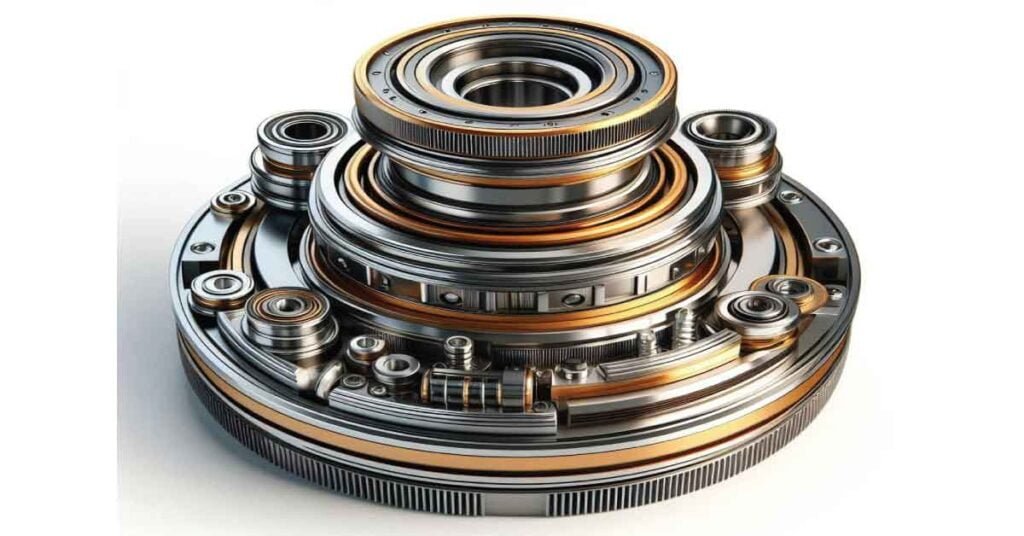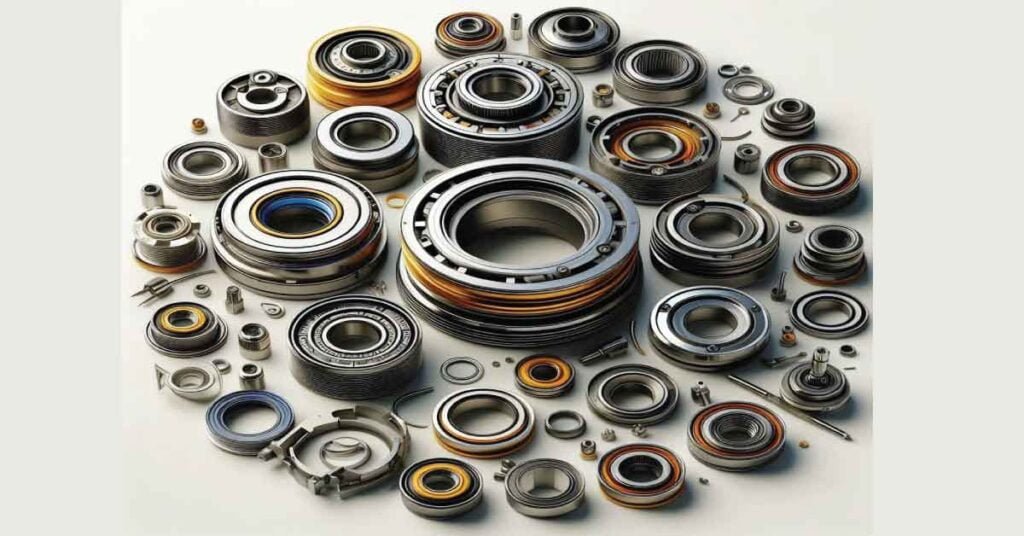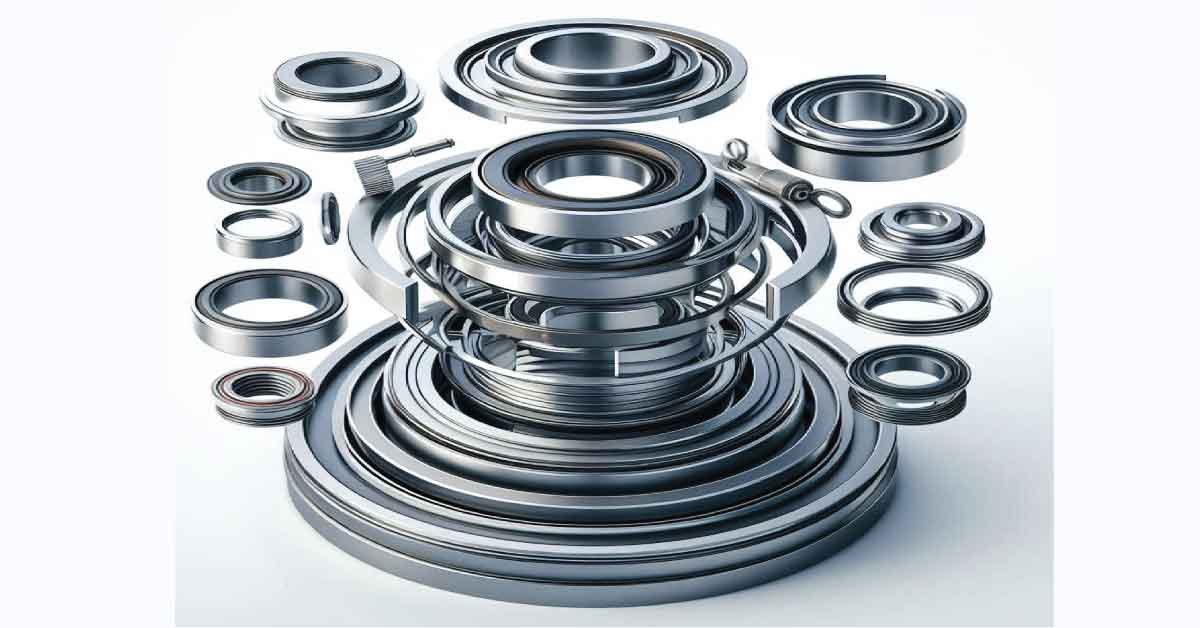Mechanical seals are critical components in many industrial and automotive applications, ensuring that fluids remain contained and equipment operates efficiently. Understanding what mechanical seals are made of can help you choose the right seal for your specific needs. This post explores the materials used in mechanical seals, their properties, and their applications in different environments. From high-temperature scenarios to various industrial uses, we’ll cover everything you need to know about the composition of mechanical seals.
What are mechanical seals made of in pumps?
Mechanical seals used in pumps are mostly made of the following; These are the, namely a stator part and a rotor part. The stationary component is typically manufactured from graphite or ceramic whilst the rotating component may be carbon or tungsten carbide. These materials are selected mostly for their wear resistance, corrosion resistance and also for their capability of withstanding high operating temperatures. Sealing surfaces we use on pumps are normally made from hard materials to take the pressure and abrasion that is characteristic of pumpage.
Also, for secondary sealing elements, used elastomers or flexible polymers, such as Viton, nitrile rubber or etc. In all, the usage of these materials guarantee that the mechanical seals in the pumps work appropriately even under extreme pressure and requirements.
What materials are used in mechanical seals?
Mechanical seals are manufactured from a number of materials with regard to their working conditions. The materials for the seal faces are carbon, ceramic and tungsten carbide among others. Carbon is used for it provides lubricant to the material and also it has high pressure holding capacity. Ceramic is selected on account of its ability to withstand wear and tear and also hardness. When employed, tungsten carbide is very hard wearing and highly resistant to abrasive applications. The sealing elements can still consist of elastomers such as Viton, EPDM or nitrile rubber that possess the ability to flex and provide the necessary sealing to prevent leaks. The type of materials used may be based on such parameters like the type of sealed fluid, temperature and pressure at which the equipment will work. Each of the materials is chosen carefully making sure that it will have the capability to perform the required and meet the necessary durability of a mechanical seal.
What is a mechanical seal made of?
A mechanical seal typically consists of several materials that work together to prevent leakage in rotating equipment. The core components include a seal face, often made from hard materials like ceramic or tungsten carbide, and a counterface, which might be composed of carbon or a similar material. The faces are pressed together to create a tight seal. Elastomers, such as Viton or nitrile rubber, are used for the secondary sealing elements to ensure flexibility and adaptability. Springs or other mechanical elements are incorporated to maintain the required pressure on the seal faces. Each component is selected for its ability to withstand the specific operating conditions, including temperature, pressure, and chemical exposure.
What are mechanical seals made of in industrial applications?
Mechanical seals used in industrial applications are made using materials that are proven to withstand bad operating conditions. Some of the regular used materials are ceramics, tungsten carbide and carbon for the seal faces. Hence, ceramic and tungsten carbide are used as they are hard materials that may not wear out easily and are strong under high pressure. Lubrication is the key reason that Carbon is used. The secondary sealing elements may be rubber such as Viton or EPDM as they are capable of withstanding the effect of chemicals and heat. On the same note, the metal parts of the seal may be manufactured from stainless steel or other high strength alloy. These are selected depending on the needs of the process that is to be sealed together with the fluids type to be sealed and the environment.
What are the components of a mechanical seal made of?
A mechanical seal has different parts all of which are made of certain material to enhance the sealing process. The principal structures consist of the seal faces that may consist of ceramic or tungsten carbide material. These materials offer the aspect of strength and antagonism to wear. Carbon or similar material may be used in the construction of the counterface, which is that part which comes into contact with the seal face. Elastomers, such as Viton or nitrile rubber, are used for the sealing elements to create a flexible and leak-proof barrier. Springs or other mechanical elements are typically made from stainless steel or other high-strength alloys to maintain the necessary pressure on the seal faces. Each component is designed to withstand the operational demands and ensure a reliable seal.
What materials are used for mechanical seal faces?
Mechanical seal faces are designed from materials known to be hard wearing and generally resistant to wear and tear. Some of the most frequently utilized materials are ceramic, tungsten carbide and carbon. The faces are made from ceramics that offer high cutting hardness and excellent abrasion resistant, which enables them to be used in applications where high pressure and high heat are incorporated. Tungsten carbide faces are highly durable and suitable to come in contact with abrasive fluids. Carbon faces are also desirable because they help minimize the level of friction that occurs in usage and this leads to minimum wear of the surfaces.
The material used depends on the function of the welded seal and the types of fluids which may be in contact with the welded seal. All of the materials are properly chosen so that mechanical seal will provide its best performance and durability.
What are mechanical seals made of in automotive applications?
Mechanical seal automotive application can operate in high temperature, high pressure conditions and chemically hostile environments. These seals often have faces which have carbon, ceramic, or Tungsten carbide on them as the facing material. Carbon is used due to its ability to withstand high pressures as well as due to it being self lubricating. That is why material such as ceramic or tungsten carbide are used because they are very hard and can resist wear. The secondary sealing elements usually come in the form of elastomers like the Viton or EPDM because they can adapt to the automotive environment.
Additionally, metal parts of the seal are often made from stainless steel or other high-strength alloys to ensure durability. The materials are selected to ensure reliable performance and longevity in the demanding conditions of automotive systems.
What are Mechanical Seals? They are crucial components used to prevent leakage in various systems. Discover the different types of Mechanical Seals available and how each type is designed to handle specific conditions. Explore our full post to gain detailed insights and make informed choices for your needs.

What are the different materials used in mechanical seals?
Mechanical seals are made of various materials in which each of them has been chosen based on the properties it has for sealing. The faces of the seal that determine the role of the seal are usually manufactured out of a variety of materials such as ceramic, tungsten carbide or carbon. Ceramic is hard and resistant to wear thus making it ideal for high pressure systems. Tungsten carbide has great wear resistance and also does not require much maintenance when placed in abrasive applications. Carbon provides for self lubricating ability hence reducing friction.
The secondary sealing elements commonly include elastomers like Viton, EPDM, or nitrile rubber, which provide flexibility and resistance to chemicals and temperature changes. The choice of materials depends on the application’s specific needs and operating conditions.
What are mechanical seals made of for high-temperature applications?
For instance in heat generating processes, mechanical seals are designed in materials that are capable of withstanding the heat and deforming. The faces of the seal are generally made up of materials such as carbon, ceramic or tin tungsten carbide. Ceramic and tungsten carbide are preferred for their ability to endure high temperatures without degrading. Carbon is used for its self-lubricating properties, which help maintain performance under thermal stress.
The secondary sealing elements typically use high-temperature elastomers such as Viton or fluorocarbon rubber, which can handle the elevated temperatures without losing flexibility. Metal parts of the seal are usually made from high-strength alloys like stainless steel to ensure durability. These materials are carefully selected to ensure reliable performance in high-temperature environments.
What are the typical materials used in mechanical seals?
Typical materials used in mechanical seals include a range of hard and soft components designed to ensure effective sealing. The seal faces are commonly made from hard materials such as ceramic, tungsten carbide, or carbon. Ceramic and tungsten carbide offer high hardness and resistance to wear, while carbon provides self-lubrication. The secondary sealing elements are usually made from elastomers like Viton, nitrile rubber, or EPDM, which provide flexibility and resistance to chemicals and temperature fluctuations. Metal components, such as springs or housing parts, are often made from stainless steel or other durable alloys. The selection of materials is based on the specific requirements of the application, including the type of fluid being sealed and the operating conditions.

Conclusion
In conclusion, the various types of materials that are used in the manufacturing of mechanical seals are selected bearing in mind their suitability to offer value under pressure and in other testing circumstances. Both the ceramic and tungsten carbide used for the hard faces, or the elastomers used in sealing elements, all bear their own significance in determining the efficiency of the seal. Consequently, anyone that understands these materials will be in a position to select the right mechanical seals for specific applications thus embracing long lasting and highly efficient equipment.
Mechanical Stress Analysis is crucial for understanding how equipment handles various forces. In our latest article, we explore how this analysis impacts Mechanical Equipment Maintenance and why it’s essential for ensuring long-term performance. Dive into our full post for detailed insights and practical tips to enhance your equipment’s reliability.
FAQs on What Are Mechanical Seals Made Of
What Are Mechanical Seals Made Of in Industrial Applications?
Mechanical seals used in industrial applications are made from materials selected for their durability and resistance to harsh conditions. Commonly used materials include ceramic, tungsten carbide, and carbon for the seal faces. Ceramic and tungsten carbide are chosen for their hardness and ability to withstand high pressures and abrasive conditions. Carbon is valued for its self-lubricating properties. Elastomers such as Viton and nitrile rubber are used for secondary sealing elements to ensure flexibility and prevent leaks. The choice of materials depends on the specific requirements of the industrial process.
What Are Mechanical Seals Made Of for Automotive Use?
In automotive applications, mechanical seals are designed to handle high temperatures, pressures, and chemical exposure. The seal faces are often constructed from materials such as carbon, ceramic, or tungsten carbide. Carbon is valued for its self-lubricating properties and ability to manage high pressures. Ceramic and tungsten carbide provide exceptional hardness and resistance to wear, making them suitable for the demanding conditions of automotive systems. Secondary sealing elements are usually made from high-temperature elastomers like Viton or EPDM to ensure flexibility and durability. Metal parts are often constructed from stainless steel or other robust alloys to ensure the seal’s longevity.
What Are Mechanical Seals Made Of in High-Temperature Applications?
For high-temperature applications, mechanical seals are made from materials that can withstand extreme heat without degrading. The seal faces are typically made from ceramic or tungsten carbide due to their ability to endure high temperatures while maintaining hardness and resistance to wear. Carbon is also used for its self-lubricating properties, which help reduce friction under thermal stress. The secondary sealing elements are made from high-temperature elastomers like Viton or fluorocarbon rubber, which can handle elevated temperatures without losing their flexibility. The choice of materials ensures that the mechanical seal performs reliably in high-temperature environments.
What Are Mechanical Seals Made Of in Pump Systems?
Mechanical seals used in pump systems are made from materials selected for their ability to handle the pressure, temperature, and chemical exposure typical in these applications. The seal faces are often made from durable materials such as ceramic, tungsten carbide, or carbon. Ceramic and tungsten carbide offer high hardness and wear resistance, while carbon provides self-lubricating properties. The secondary seals, usually made from elastomers like Viton or nitrile rubber, provide flexibility and prevent leakage. These materials are chosen based on the specific requirements of the pump system, including the type of fluid being pumped and the operating conditions.
What Are Mechanical Seals Made Of in Various Industries?
Mechanical seals used across various industries are made from a range of materials tailored to specific applications. The seal faces are commonly made from hard materials such as ceramic, tungsten carbide, or carbon. Ceramic and tungsten carbide are preferred for their hardness and durability in abrasive or high-pressure environments, while carbon is selected for its self-lubricating properties. Elastomers such as Viton or EPDM are used for the secondary sealing elements to ensure flexibility and resistance to chemicals and temperature changes. The choice of materials depends on the industry’s specific requirements, including the type of fluids, pressure, and temperature conditions.

